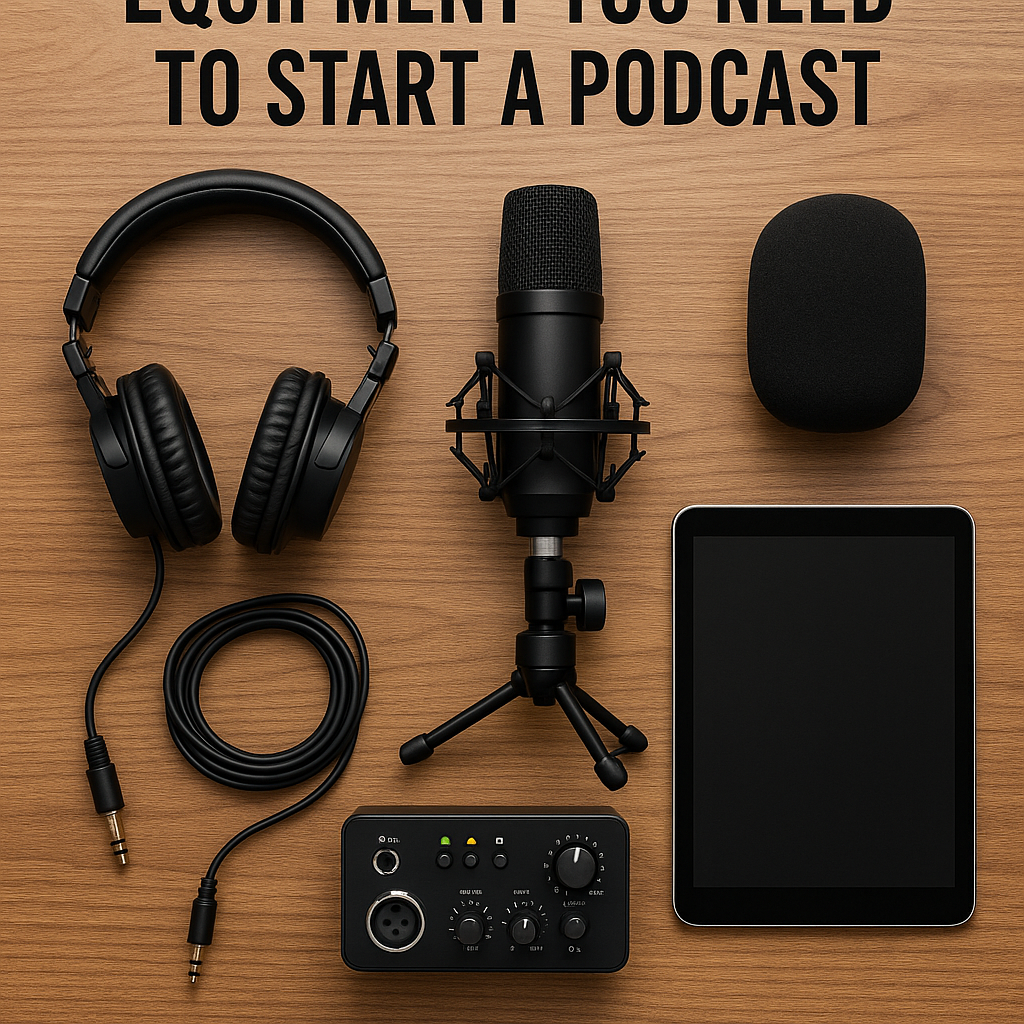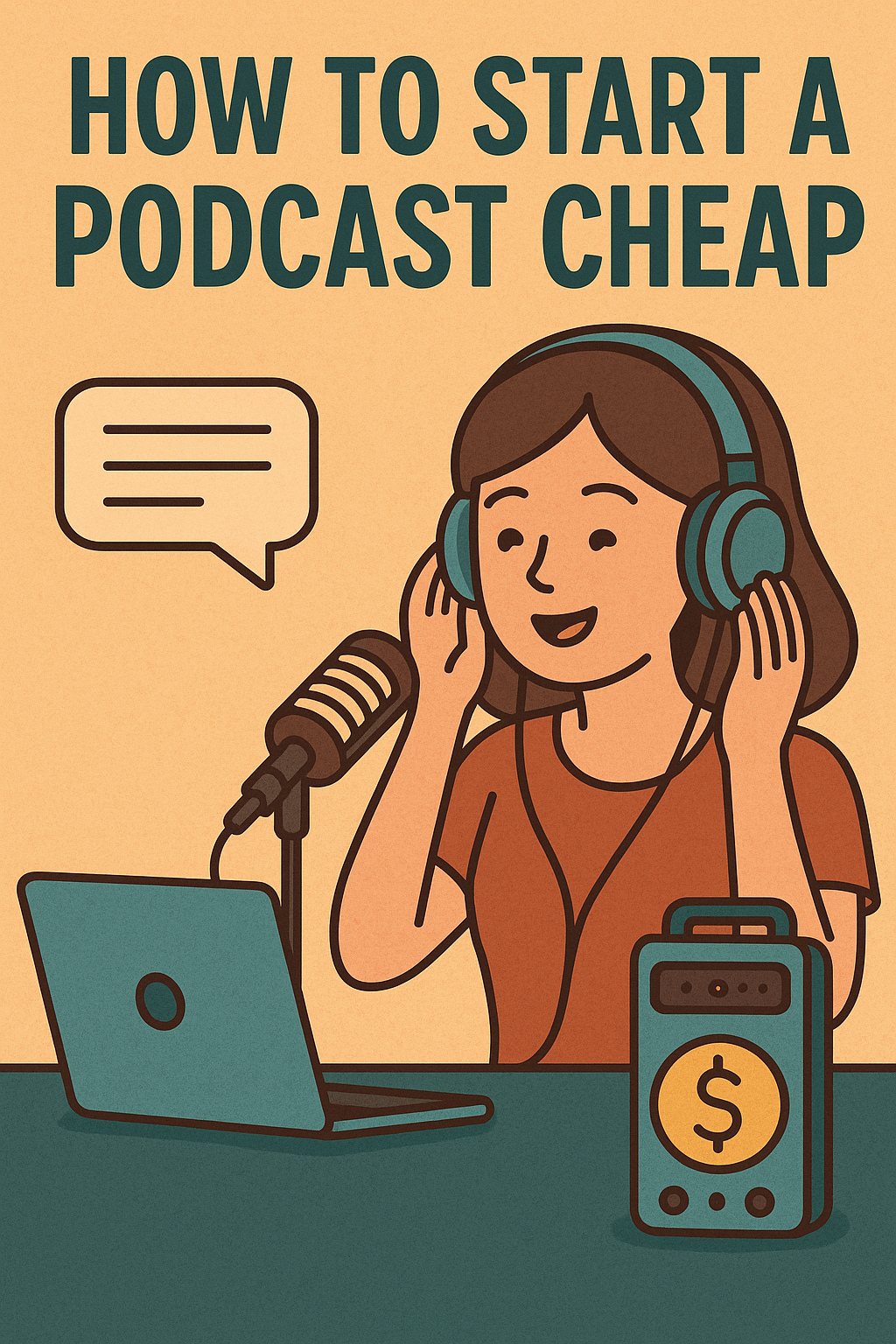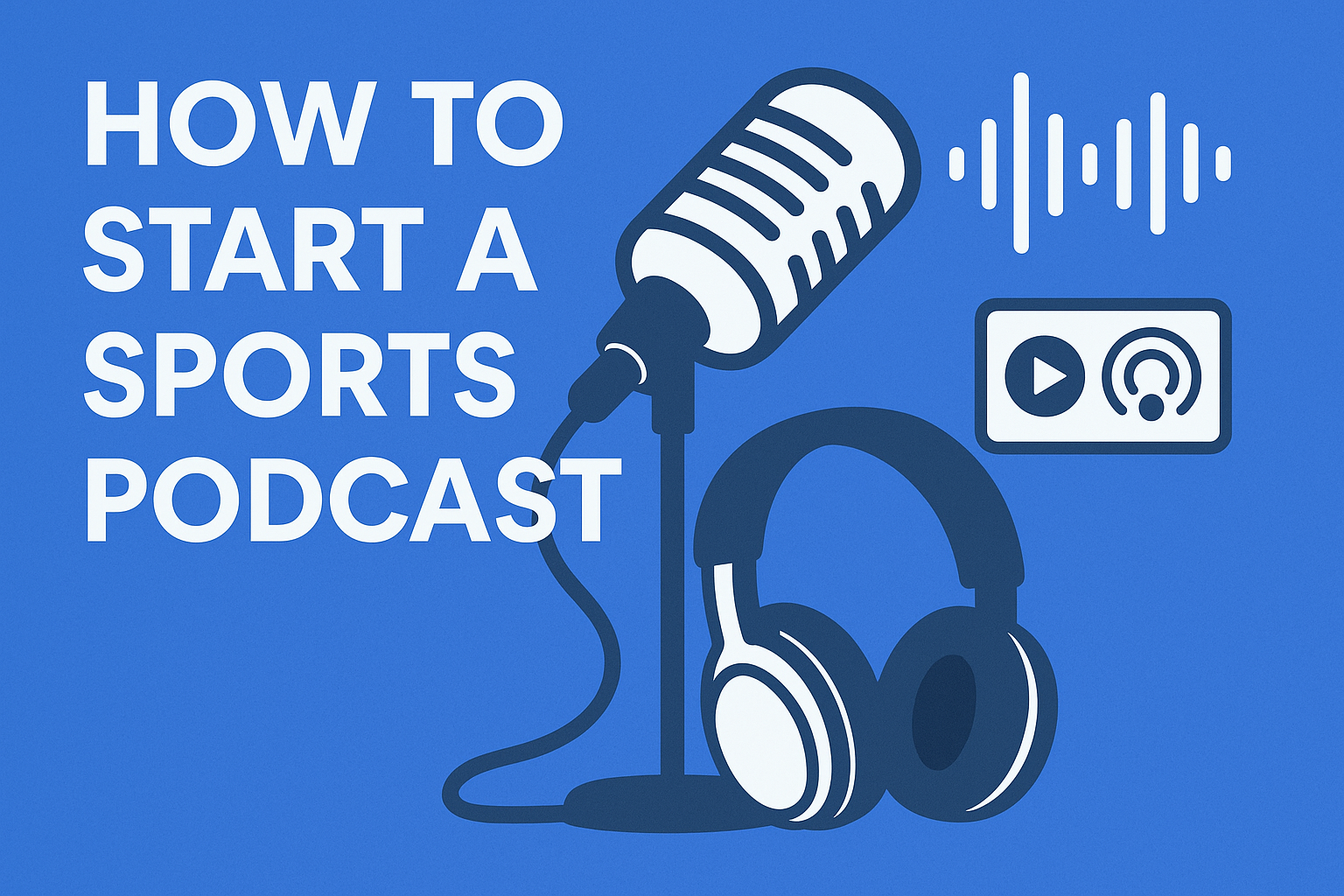Equipment You Need to Start a Podcast - Complete Beginner's Guide 2025
Discover the essential equipment you need to start a podcast in 2025. From budget-friendly setups to professional gear, this complete guide covers everything new podcasters need.

The Complete Guide to Equipment You Need to Start a Podcast (2025)
Starting a podcast can feel overwhelming when you're staring at endless lists of equipment recommendations and conflicting advice about what gear you actually need. The truth? You don't need to break the bank to create professional-sounding content that engages your audience.
Whether you're planning to record from your bedroom or invest in a dedicated studio setup, this comprehensive guide breaks down exactly what equipment you need to start a podcast, with options for every budget and skill level.
We'll cover everything from the essential must-haves to the nice-to-have upgrades, so you can make informed decisions and avoid costly mistakes that many new podcasters make.
Essential Equipment You Need to Start a Podcast (The Basics)
Let's start with the absolute minimum equipment you need to start a podcast that sounds professional:
1. Microphone (Most Important Investment)
Your microphone is the most critical piece of equipment you need to start a podcast. Poor audio quality will turn away listeners faster than any other factor.
Budget Option ($30-80):
- Audio-Technica ATR2100x-USB: Versatile XLR/USB option
- Samson Q2U: Dynamic microphone perfect for beginners
- Blue Yeti Nano: Compact USB condenser mic
Professional Option ($100-300):
- Shure SM7B: Industry standard (used by Joe Rogan)
- Electro-Voice RE20: Broadcast-quality dynamic mic
- Rode PodMic: Designed specifically for podcasting
2. Audio Interface (For XLR Microphones)
If you choose an XLR microphone, you'll need an audio interface to connect it to your computer.
Budget Option ($50-150):
- Focusrite Scarlett Solo: Single input interface
- PreSonus AudioBox USB 96: Reliable entry-level option
- Behringer U-Phoria UM2: Ultra-budget choice
Multi-Guest Option ($150-400):
- Focusrite Scarlett 2i2: Two inputs for interviews
- Zoom PodTrak P4: Podcast-specific interface
- RødeCase Podcaster: All-in-one podcast solution
3. Closed-Back Headphones ($50-200)
Essential for monitoring your audio quality during recording and editing.
Recommended Options:
- Sony MDR-7506: Industry standard monitoring headphones
- Audio-Technica ATH-M40x: Excellent value for money
- Beyerdynamic DT 770 Pro: Professional-grade comfort
4. Recording Software (Free to $60/month)
You need software to record and edit your podcast episodes.
Free Options:
- Audacity: Simple, reliable, and completely free
- GarageBand: Mac users' go-to choice
- Anchor: Browser-based recording and hosting
Paid Options:
- Adobe Audition: Professional editing suite ($22.99/month)
- Hindenburg Pro: Designed for voice content ($399)
- Reaper: Affordable professional DAW ($60)
Complete Equipment Setups by Budget
Budget Setup ($100-300 Total)
The "Bedroom Podcaster" Kit:
- Microphone: Samson Q2U ($69)
- Audio Interface: Focusrite Scarlett Solo ($130)
- Headphones: Audio-Technica ATH-M40x ($99)
- Software: Audacity (Free)
- Accessories: Boom arm and pop filter ($40)
Total: ~$340
This setup will give you broadcast-quality audio that rivals much more expensive setups.
Mid-Range Setup ($500-1000 Total)
The "Serious Hobbyist" Kit:
- Microphone: Shure SM7B ($400)
- Audio Interface: Focusrite Scarlett 2i2 ($170)
- Headphones: Sony MDR-7506 ($100)
- Cloudlifter: Cloudlifter CL-1 ($149) (for SM7B gain boost)
- Acoustic Treatment: Basic foam panels ($100)
- Accessories: Professional boom arm and shock mount ($80)
Total: ~$999
Perfect for podcasters ready to invest in professional-grade equipment.
Professional Setup ($1500+ Total)
The "Studio Quality" Kit:
- Microphone: Electro-Voice RE20 ($450)
- Audio Interface: RødeCase Podcaster ($199)
- Headphones: Beyerdynamic DT 770 Pro ($179)
- Mixer: Zoom PodTrak P8 ($200)
- Acoustic Treatment: Professional panels and bass traps ($400)
- Monitoring: Studio monitors for editing ($300)
- Accessories: Professional boom arms, shock mounts, cables ($200)
Total: ~$1,928
This setup handles multiple guests, live streaming, and provides studio-quality results.
Beyond the Basics: Additional Equipment for Growing Podcasters
Acoustic Treatment ($50-500)
Why You Need It: Even the best microphone sounds amateur in a bad acoustic environment.
Budget Solutions:
- Moving blankets: Hang around your recording space ($30-50)
- Acoustic foam panels: Basic room treatment ($100-200)
- Portable vocal booth: Foldable isolation shield ($80-150)
Professional Solutions:
- Acoustic panels: Custom room treatment ($300-1000)
- Bass traps: Corner treatments for low frequencies ($200-400)
- Diffusion panels: Scatter sound reflections ($150-300)
Backup and Redundancy Equipment
Portable Recorder: Zoom H1n Handy Recorder ($120)
- Records directly to SD card
- Perfect backup for technical failures
- Great for remote interviews
Backup Microphone: Audio-Technica ATR2100x-USB ($79)
- Dual XLR/USB connectivity
- Reliable backup option
- Can run on batteries
Multi-Guest Interview Equipment
Multiple Microphones: Budget for 2-4 microphones Audio Mixer: Behringer Xenyx Q802USB ($89) Headphone Amplifier: Behringer HA400 ($25) Extra Headphones: One pair per guest ($50 each)
Choosing the Right Microphone: Dynamic vs. Condenser
Understanding microphone types is crucial when selecting equipment you need to start a podcast:
Dynamic Microphones (Recommended for Beginners)
Pros:
- Less sensitive to room noise and reflections
- Don't require phantom power
- More forgiving of poor acoustic treatment
- Generally more durable
Best For:
- Home recording setups
- Noisy environments
- Beginners without treated rooms
Top Picks:
- Samson Q2U (best value)
- Shure SM58 (live performance standard)
- Shure SM7B (broadcast standard)
Condenser Microphones (For Treated Spaces)
Pros:
- More sensitive and detailed sound capture
- Better frequency response
- Great for well-treated rooms
Cons:
- Pick up more room noise
- Require phantom power
- More sensitive to handling noise
Best For:
- Treated recording spaces
- Solo recording setups
- Detail-oriented productions
Top Picks:
- Audio-Technica AT2020 (affordable quality)
- Rode PodMic (podcast-specific condenser)
- Electro-Voice RE320 (broadcast condenser)
Common Equipment Mistakes New Podcasters Make
1. Overspending on Gear Before Learning Basics
Many beginners think expensive equipment will automatically make them sound professional. Focus on:
- Learning proper microphone technique
- Understanding basic audio editing
- Developing consistent content first
2. Ignoring Room Acoustics
A $500 microphone in a bad room sounds worse than a $50 microphone in a good room.
Quick Fixes:
- Record in your closet (clothes provide natural dampening)
- Use heavy blankets to create a makeshift booth
- Avoid hard surfaces and parallel walls
3. Buying USB Microphones for Multiple Guests
USB microphones typically can't be used together easily. If you plan to have guests:
- Start with XLR microphones
- Invest in an audio interface with multiple inputs
- Plan for expansion from day one
4. Forgetting About Monitoring
Many new podcasters skip headphones and miss:
- Audio level problems during recording
- Background noise and distractions
- Technical issues that ruin entire episodes
Essential Accessories You Shouldn't Overlook
Boom Arms and Shock Mounts ($30-100)
Why You Need Them:
- Reduces handling noise and vibrations
- Positions microphone optimally
- Keeps your hands free for notes
Recommended Options:
- InnoGear Microphone Stand: Budget boom arm ($25)
- Rode PSA1: Professional broadcast arm ($99)
- Gator Frameworks: Heavy-duty option ($89)
Pop Filters and Windscreens ($10-30)
Essential for:
- Reducing plosive sounds (P's and B's)
- Protecting microphone from moisture
- Maintaining consistent audio quality
Cables and Adapters ($20-60)
Don't Forget:
- XLR cables (one per microphone)
- USB cables for interfaces
- 1/4" TRS cables for headphones
- Adapters for different connector types
Power Solutions
Uninterruptible Power Supply (UPS): $60-150
- Protects against power outages
- Prevents lost recordings
- Essential for longer episodes
Software Solutions Beyond Recording
Editing and Post-Production
Free Options:
- Audacity: Complete editing suite
- Anchor: Built-in editing tools
- GarageBand: Mac-exclusive but powerful
Paid Options:
- Adobe Audition: Industry standard ($22.99/month)
- Hindenburg Pro: Voice-optimized editing ($399)
- Logic Pro: Mac-based professional suite ($199)
AI-Powered Tools for Podcasters
Transcription Services:
- Otter.ai: Real-time transcription ($8.33/month)
- Rev.com: Human transcription ($1.25/minute)
- Descript: AI editing with transcription ($12/month)
Content Repurposing: Transform your podcast episodes into newsletters, blog posts, and social media content automatically. Tools like our Podcast to Newsletter Generator help you maximize the value of your recorded content.
Setting Up Your First Recording Session
Pre-Recording Checklist
- Test all equipment 30 minutes before recording
- Check audio levels and adjust gain settings
- Close all unnecessary applications to prevent interruptions
- Turn off phones and notifications
- Have water nearby but away from equipment
Recording Best Practices
- Maintain consistent distance from microphone (6-8 inches)
- Speak directly into the microphone (not above or to the side)
- Monitor audio levels throughout recording
- Record room tone (30 seconds of silence) for editing
- Save your project frequently during long sessions
Post-Recording Workflow
- Back up your raw recordings immediately
- Listen to the entire episode before editing
- Note timestamps for major edits needed
- Edit for content first, audio quality second
- Export in multiple formats (MP3, WAV) as needed
Future-Proofing Your Podcast Equipment
Scalability Considerations
When choosing equipment you need to start a podcast, think about growth:
Start Small but Smart:
- Choose XLR over USB for expandability
- Buy interfaces with extra inputs
- Invest in quality basics rather than quantity
Upgrade Path Planning:
- Year 1: Focus on microphone and headphones
- Year 2: Add acoustic treatment and backup equipment
- Year 3: Upgrade to professional interfaces and monitoring
Emerging Technology Trends
What's Coming in 2025:
- AI-powered noise reduction in real-time
- Wireless XLR systems for more flexibility
- Cloud-based recording platforms for remote collaboration
- Integrated streaming and recording solutions
Maintenance and Care for Your Equipment
Regular Maintenance Tasks
Weekly:
- Clean microphone grilles and pop filters
- Check all cable connections
- Update software and drivers
Monthly:
- Deep clean equipment with appropriate solutions
- Check for firmware updates
- Test backup equipment and procedures
Annually:
- Replace consumable items (pop filters, windscreens)
- Calibrate audio interfaces if needed
- Evaluate equipment performance and plan upgrades
Building Your Equipment Kit Over Time
Phase 1: Getting Started (Months 1-3)
Focus on the absolute essentials:
- One quality microphone
- Basic audio interface
- Reliable headphones
- Free recording software
Phase 2: Improving Quality (Months 4-6)
Add comfort and quality improvements:
- Acoustic treatment for your space
- Professional boom arm and shock mount
- Backup recording solution
- Paid editing software if needed
Phase 3: Professional Growth (Months 7-12)
Expand capabilities:
- Multi-guest recording setup
- Professional monitoring solutions
- Advanced editing and processing tools
- Streaming and live recording capabilities
Budget-Saving Tips for New Podcasters
Money-Saving Strategies
- Buy used equipment from reputable sellers
- Start with free software and upgrade when needed
- DIY acoustic treatment using household items
- Bundle purchases for better deals
- Consider rental equipment for special episodes
When to Splurge vs. Save
Invest More In:
- Microphones (your voice is everything)
- Headphones (you need to hear problems)
- Audio interfaces (reliability matters)
Save Money On:
- Cables (basic ones work fine)
- Pop filters (cheap ones work well)
- Initial acoustic treatment (DIY solutions work)
Your Equipment Purchase Action Plan
Week 1: Research and Budget
- Determine your total budget for equipment
- Choose your primary recording location
- Decide on solo vs. multi-guest format
- Research specific models within your budget
Week 2: Make Essential Purchases
- Buy your microphone and audio interface
- Purchase quality headphones
- Get basic accessories (boom arm, pop filter)
- Download and test free software
Week 3: Setup and Testing
- Set up your recording space
- Install and configure all software
- Record test episodes and evaluate quality
- Make acoustic improvements as needed
Week 4: First Real Recording
- Plan your first official episode
- Do a full equipment check before recording
- Record, edit, and publish your debut episode
- Evaluate what worked and what needs improvement
The Bottom Line
The equipment you need to start a podcast doesn't have to break the bank or overwhelm you with choices. Start with the basics—a quality microphone, audio interface, headphones, and free editing software—and build your kit as your podcast grows.
Remember: your content and consistency matter more than having the most expensive gear. Many successful podcasters started with basic equipment and upgraded over time as their audience and skills developed.
Focus on creating valuable content for your listeners, maintain consistent audio quality, and invest in better equipment as your podcast gains traction. The most important equipment you need is the commitment to show up regularly and serve your audience.
Ready to turn your podcast episodes into engaging newsletters? Our Podcast to Newsletter Generator helps you repurpose your audio content into compelling written format that grows your audience beyond just listeners. Start your free trial →
Frequently Asked Questions
Q: What's the minimum I need to spend to start a podcast? A: You can start with quality equipment for under $200 using a USB microphone like the Samson Q2U ($69), basic headphones ($50), and free software like Audacity. However, a $300-500 budget gives you much more professional results.
Q: Do I need an expensive microphone to sound professional? A: Not necessarily. A $70 Samson Q2U in a well-treated room will sound better than a $400 Shure SM7B in a bad acoustic environment. Focus on your recording space first, then upgrade your microphone.
Q: Should I start with USB or XLR microphones? A: For long-term flexibility, start with XLR microphones and an audio interface. USB microphones are easier to set up but limit your ability to expand to multiple microphones or professional setups later.
Q: What's the most important piece of equipment for podcast quality? A: Your microphone is the most critical investment, followed closely by acoustic treatment of your recording space. These two factors have the biggest impact on your podcast's professional sound quality.
Q: How much should I spend on my first podcast setup? A: Budget $300-500 for a solid beginner setup that will grow with you. This covers a quality XLR microphone, audio interface, headphones, and basic accessories. You can always start smaller and upgrade specific components over time.
Ready to master podcasting equipment and turn your episodes into multiple content formats? Download our free "Podcast Equipment Checklist" with specific product recommendations and setup guides that have helped 500+ new podcasters launch successfully.
Related Articles

How to Start a Podcast Cheap - Complete Budget Guide 2025
How to Start a Podcast Cheap: The Complete Budget Guide (2025) Think you need thousands of dollars to start a podcast? Think again. With the right approach, you can launch a professional-sounding podcast for less than the cost of a nice dinner out. The biggest misconception new podcasters have is...

How to Start a Sports Podcast: Complete Guide for 2025 (Free Equipment List)
How to Start a Sports Podcast: The Complete Beginner's Guide for 2025 Sports podcasting has exploded into a billion-dollar industry, with successful shows earning millions while providing fans with deeper analysis, insider access, and passionate discussions about their favorite teams and athletes....
Ready to Transform Your Podcast?
Convert your podcast episodes into engaging newsletters that grow your audience and increase engagement.
Get Started Free